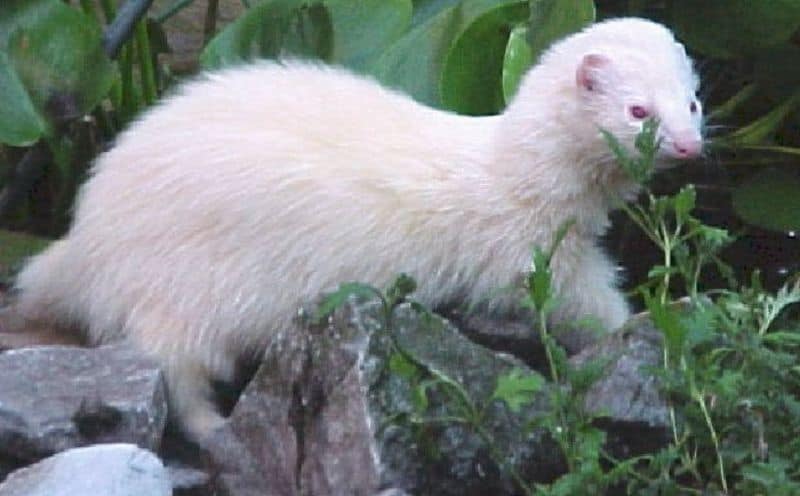Although ferrets are super bendy creatures, they are vertebrates like all mammals. Their unique skeleton allows them to slither, bend, and climb through tunnels. This was key for ferrets when they were first bred, not as pets but as hunters.
Keep reading to learn everything there is to know about ferret spines and why these animals are so bendy!
Do Ferrets Have Spines?

Ferrets have long, flexible spines.
©jurra8/Shutterstock.com
Ferrets have spines, but they’re much more flexible than ours. This is because of how their bodies are structured.
Evolution has allowed ferrets to grow long and flexible to hunt their main prey: rodents. The first domesticated ferrets were used for hunting rabbits, snaking through their burrows to flush them out of hiding.
Ferrets also have short legs that allow them to squeeze into tight spaces. They have five long, sharp claws on each foot to help them dig. Wild black-footed ferrets have a similar body shape that also aids them in hunting rodents.
How are Ferrets so Bendy?
Ferrets’ spines contain fifteen thoracic, five lumbar, and three sacral vertebrae. This means that they have fifteen vertebrae (bones) on their torso, five on their lower back, and three near their pelvis. They also have seven vertebrae in their necks and eighteen on their tail. That’s a long spine!
Their necks are incredibly long for their bodies, and their tail makes up a third of their total length. Ferrets can move like an eel or a snake due to their unique bone structure. Their bones are also thin and lightweight, allowing for even more movement.
Why are Ferrets so Stretchy?

Ferrets have a unique skeleton that allows them to fit into crevices and burrows.
In addition to being slinky, ferrets are also quite stretchy. This is also due to their unique skeleton and spine.
When hunting underground, ferrets can stretch and expand their body length considerably—up to 30%! When walking ordinarily, a ferret’s back is slightly arched. When they crouch to climb into an enclosed space, their spine straightens out, making them look even longer.
Ferrets’ back legs are longer than their front legs, and to climb into a burrow (or to play in a tunnel in your home), they lower their back legs and bottom to fit.
Can you put a Ferret Around Your Neck?
Carrying a ferret on your neck may seem fun, but it can be dangerous for them. Your neck is very high off the ground, even when you’re sitting, and ferrets are incredibly rambunctious. If they don’t sit still, they can fall off your neck and injure themselves.
Putting a ferret around your neck for a quick photo or allowing them to run across your neck during play is okay as long as you’re looking out for their safety first. Stay as low to the ground as possible and be ready to grab your ferret if they fall. Your hands should be close by so that you can pick them up or catch them before they make any bad decisions, like jumping off your shoulder.
A better way to carry your ferret is by holding them with one hand at their armpits and another under their bottom. Lift them carefully, and don’t take them far from the ground before you’re sure you have a good hold on them.
Ferrets can be very wriggly, so it’s important you handle them without dropping them or allowing them to jump from up high.
Do Ferrets have Problems with their Spines?

Ferrets can suffer from chordomas, which are tumors that occur on the spine.
©Couperfield/Shutterstock.com
A ferret’s long, bendy spine has its advantages and disadvantages when it comes to its health. The good news is that injuries to their spine are rare. Ferrets don’t often suffer from broken spines or injured disks. However, chordomas are common. These are tumors that occur on the spine. Although they grow slowly, they are malignant (cancerous).
Chordomas can occur anywhere on a ferret’s spine. If they’re somewhere like the tip of the tail, then a veterinarian can amputate it to save the ferret’s life. Unfortunately, chordomas in the center of the spine are much more difficult to treat and often result in death.
One reason that ferrets are so prone to tumors is poor breeding. Unfortunately, most ferrets in the United States are bred by ferret mills. These are very similar to puppy mills in the way they function. Breeding mills care about money and having a constant supply of pets to sell—not about the health and wellbeing of the animals they breed.
Adrenal problems and short lifespans are also prevalent in pet store ferrets.
Ferret Skeleton

48 vertebrae make up a ferret’s spine.
©Polyoutis / Creative Commons – License
A ferret’s spine runs throughout its body from the head all the way down the tail. These limber and mischievous critters move easily through winding tubes or burrows underground.
Ferrets are also good at fitting into tiny crevices and hiding away, which is why ferret-proofing our homes is so important!
The photo featured at the top of this post is © Kerry Hargrove/Shutterstock.com
Thank you for reading! Have some feedback for us? Contact the AZ Animals editorial team.






